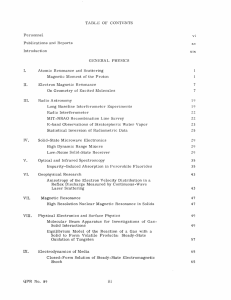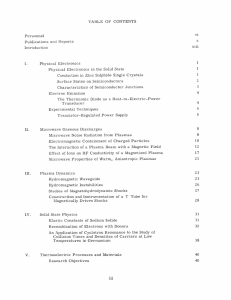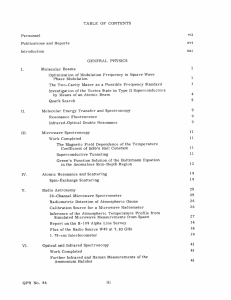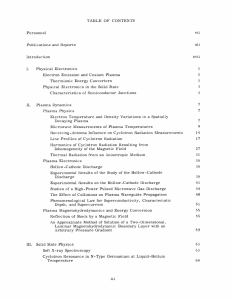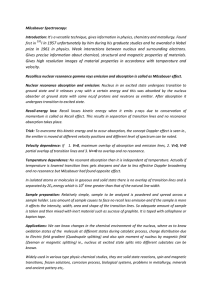by L. Friedland and M. Porkolab PFC/JA-80-21 80/20
advertisement
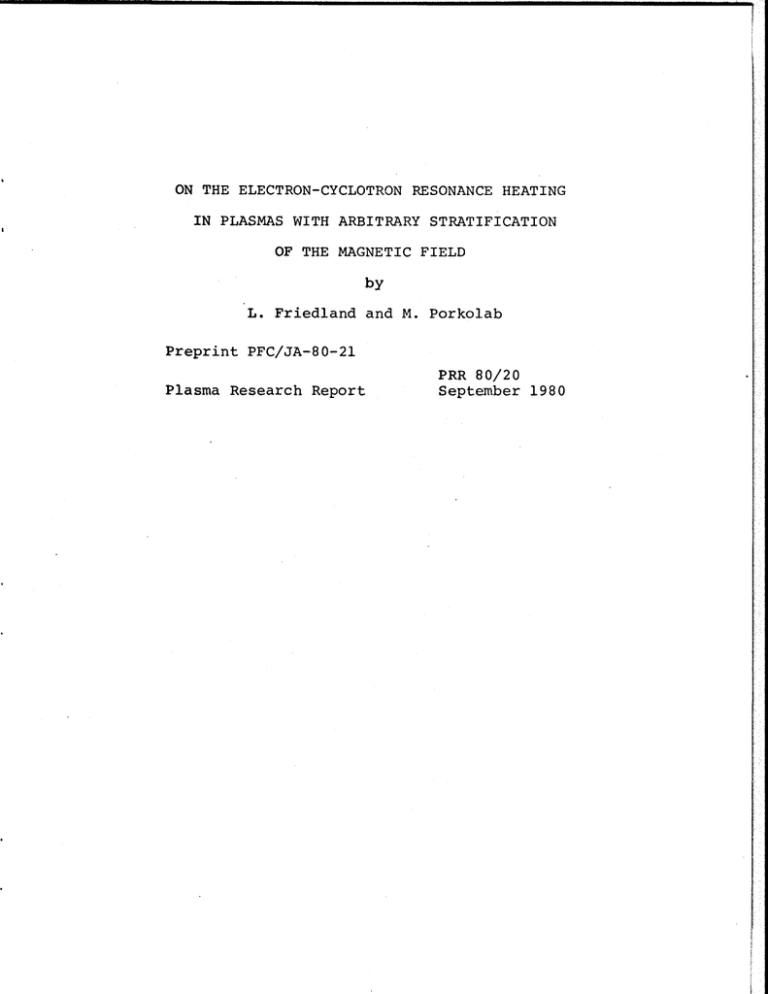
ON THE ELECTRON-CYCLOTRON RESONANCE HEATING IN PLASMAS WITH ARBITRARY STRATIFICATION OF THE MAGNETIC FIELD by L. Friedland and M. Porkolab Preprint PFC/JA-80-21 Plasma Research Report PRR 80/20 September 1980 - 1 ON THE ELECTRON-CYCLOTRON RESONANCE HEATING IN PLASMAS WITH ARBITRARY STRATIFICATION OF THE MAGNETIC FIELD L. Friedland Yale University New Haven, Connecticut 06520 and M. Porkolab Massachusetts Institute of Technology Cambridge, Massachusetts 02139 Heating of magnetically confined plasmas near the electroncyclotron resonance frequency (ECRH) is currently being investigated for both toroidal and mirror-type devices.' Theoretical studies in simple one-dimensional models have shown the possibility of significant absorption of the electromagnetic energy even at temperatures of a few hundred electron volts.4- 5 In some of these cases, analytic approximations for the absorption coefficients for different electromagnetic modes were derived. example, Eldridge, etail6 For have shown that for perpendicularly stratified plasmas, where the magnetic field B has a constant direction and its gradient is perpendicular to B, the transmission coefficient for the electromagnetic energy flux through the electron-cyclotron resonance is given by T = exp(-1A 1 1), (1) A = L 1 Q1 (2) where and, - 2 - 27rT Q = 1 a2 n- -e m c2 a 2 n1 ((1 - a 2 n ) (i - 1 2 n ) 2 + - a 2) - n2 (1-a2)n2 (3) . In these formulae it is assumed that.the absorption takes place in a thin layer in the neighborhood of the electron-cyclotron resonance where w-wc, parameter L in Eq. cpe /w, a= (2) n,1 =ck1 /w, ng=ck /w, 1i and n2=n 2 +n 2 1. . The is the local scale length of variation of the cyclotron frequency at the resonance surface, namely L-I c/VCcI Because of the complexity of the magnetic field geometries in realistic devices, such as tandem mirrors or bumpy torii, the use of the aforementioned simple analytic results is often not valid. The problem is usually solved by using the geometric optics approximation and numerical procedures. Such studies typically involve ray tracing, performed by using the cold plasma model. The absorp- tion of the electromagnetic energy flux is then found by computing the imaginary correction iv to the frequency of the wave due to the thermal effects and integrating v along the rays as they pass through the resonance surface.7 In this paper we shall show that simple geometric considerations allow one to derive an analytic expression for the absorption coefficient even for plasmas with arbitrary stratification of the magnetic field. Thus, the absorption may be calculated using the analytic results obtained previously for perpendicular stratification. This can result in considerable savings in the numerical work, as well as allowing one to obtain simple analytic estimates for the absorption. Consider a general two-dimensional case shown schematically in Fig. 1. (1), It can be shown8 that in general, consistent with Eq. the transmission coefficient can be found from - 3 (4) T = exp(-IAI) with +00 A = 2 v (t)dt (5) , -00 If the resonance re- where the time integration is along the ray. gion, where v makes a significant contribution in Eq. row enough, one can evaluate Eq. (5) (5), is nar- by assuming that the in- dex of refraction n remains constant and has the components corresponding to the point the ray crosses the resonance surface. Now one can use the fact that the dielectric tensor for hot Maxwellian = plasmas is a function of the wave vector 1, w and a parameter (G3c-w)/kiive, where k,, is the component of the k-vector along the direction of the magnetic field, and ve=( 2 T /m )1/2 velocity of the electrons.9 is the average Therefore C is the only variable in v which changes rapidly as the ray passes the resonance region. the other variables not only can be assumed constant in Eq. All (5), but are also independent of the directions of spatial gradients of In addition the group velocity of the various plasma parameters. with respect to com- wave v 9ca/cA involves differentiation of ponents of the k-vector and thus the direction of the ray, and the absolute value of the group velocity in the resonance region are also approximately constant and independent of the type of the spatial stratification of the plasma. +00 A = 2 +C0 2k,v f-0 +0 v( )d , v( )ds = L v()dt f Then (6) g where we used the first order expansion of the cyclotron frequency in the direction of the ray in the resonance region - 4 O- + is;-) (7) g and L =wc /(aw the ray. s) is the scale length of variation of wc along Thus, finally one has A = L F(I, r,o) (8) g The function F in the last equation is independent of the direction of V c. Therefore one can use the known result for per- pendicular stratification to find this function. In fact, if at the point where the ray crosses the resonance surface the plasma would have perpendicular stratification, by comparing Eq. (2) and Eq. (8) one would get F = Q sinO (9) where 0 is the angle between the direction of the ray and the direction of the magnetic field (see Fig. 1). Then in the general case A = LQ 1 csn where L=oC/VW cI (10) is the scale length of variation of the cyclotron frequency at the-resonance point and $ is the angle between the group velocity and Vcif.l c Consider now various limiting cases described by Eq. Clearly, for perpendicular stratification 0+$=rr/2 and Eq. duces to Eq. (2). (10). (10) re- In the plasma with parallel stratification, where Vwc is parallel to the direction of the magnetic field, one has G=a and therefore All = L Q 1 tge. In cases when =7/2, Eq. (11) (10) gives infinite absorption which is the consequence of the fact that the ray is propagating parallel - 5 - to the resonance surface, so that it stays in resonance for a long time and thus is heavily absorbed. It should be mentioned however that in such cases strong absorption predicted by Eq. (10) must be viewed only as a qualitative indication, since the assumption of the narrowness of the absorption region becomes invalid. Thus, the absorption will be limited by the thickness of the plasma slab. The angle 0 in Eq. (10) can be easily found. In fact, the components of the group velocity at the resonance surface can be found by differentiating the appropriate dispersion relation. As- suming that the ray can be described by the cold plasma model, one has at the resonance D = n2 (n2 - 1) and, since vg1 , = /3k v tg - n = -J v 1n Thus the direction of Vwc tor in Eq. (10). 11 (2n 2 -2 - a 2 ) (1 = (9D/3k 1 a 2) =L 1I c c2 (12) . (13) c remains the only unknown geometric fac(13) can be used directly in the case of the parallel stratification Eq. (11), A 0 11)/(9D/3w), (2n + n + 2a2 - 3) 1 3) n + 2a 2 - 2) Note that Eq. 2 WTe = n,, (2n2+n +2a 2 -3) [(1 (n 2 +2a 2 -2) where one gets -n') (1-a 2 ) -n ] - .(14) 2-n )+(1-a2)n2 Note also that for small angles 0 one has from Eq. (13) sinO m n1 /n,, and therefore the singularity in Eq. (3) at n.+0 disappears if one is using the general formula (10). In conclusion, we have demonstrated that using simple geometric considerations with the help of the absorption coefficient ob- - 6 - tained for perpendicular stratification one can estimate the absorption in plasmas with arbitrary stratification of the magnetic field. Our formula can be applied in a ray tracing computer code each time the ray crosses the cyclotron resonance surface. the parameters and geometric factors in Eq. All (10) are either known from a ray tracing, or can be easily evaluated. ACKNOWLEDGEMENTS This work was supported by the U.S. Department of Energy. We wish to thank valuable discussions with Dr. D. E. Baldwin and Dr. I. B. Bernstein. - 7 REFERENCES 1. V. V. Alikaev, Yu. N. Dnestrovski, and G. V. Pereverzev, Fiz. Plasmy, 3, 230 2. (1977) (Sov. J. Plasma Phys. 3, 127 (1977)). R. M. Gilgenbach, M. E. Read, K. E. Hackett, R. Lucey, B. Hui, V. L. Granatstein, K. R. Chu, A. C. England, C. M. Loring, D. C. Eldridge, H. C. Howe, A. G. Kulchar, E. Lazarus, M. Murakami, and J. B. Wilgen, Phys. Rev. Lett 44, 3. 647 (1980). I. B. Bernstein, and D. C. Baxter, Phys. Fluids (to be published). 4. M. Porkolab, Lawrence Livermore Laboratory, UCRL-52634 5. I. Fidone, G. Granata, and G. Ramponi, Phys. Fluids 21, (1978). 645 (1978). 6. D. Eldgridge, Won Namking, and A.C. England, Oak Ridge National Laboratory, ORNL/TM-6052 (1977). 7. D, B. Batchelor, Rs. C, Golfinger, and H. Weitzner, IEEE Tr. on Plasma Science PS-8, 78 (1980). 8. L. Friedland and I, 9. T, H. Stix, "The Theory of Plasma Waves" York, 1962), p. 189. B. Bernstein, Phys. Rev. (to be published). (McGraw-Hill, New - 8FIGURE CAPTIONS Fig. 1. Geometry of ray propagation in the case of generalized magnetic field stratification. rl 0 0 Pr4 ro m N F) 3 Zu Uw (ncr ZZ <t-O '0(,O

